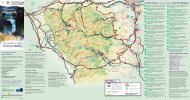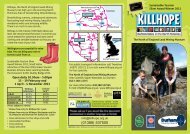How a visit to Killhope can inspire
How a visit to Killhope can inspire
How a visit to Killhope can inspire
Create successful ePaper yourself
Turn your PDF publications into a flip-book with our unique Google optimized e-Paper software.
UNIT 4C: JOURNEYS<br />
Using <strong>Killhope</strong>: Why not use a walk around the woodland as the journey, and ask the children <strong>to</strong><br />
represent it. There is so much for them <strong>to</strong> see – red squirrels at the squirrel hide, birds at the bird<br />
feeder, rabbits, the reservoir, streams, different types of trees and plants, a modern art sculpture,<br />
our ‘Go Wild with Tiles’ exhibition – children will have so much <strong>to</strong> <strong>inspire</strong> them.<br />
LEARNING OBJECTIVES POSSIBLE ACTIVITIES LEARNING OUTCOMES<br />
Exploring and developing ideas (1)<br />
• To question and make<br />
thoughtful observations<br />
about starting points for<br />
their work.<br />
• To collect visual and<br />
other information <strong>to</strong> help<br />
them develop their<br />
ideas.<br />
• To question and make<br />
thoughtful observations<br />
about the stimulus for<br />
their work.<br />
• To investigate and<br />
combine visual and<br />
tactile qualities of<br />
materials and processes<br />
and <strong>to</strong> match these<br />
qualities <strong>to</strong> their ideas<br />
about a journey.<br />
• Explore a range of maps (old<br />
and new), aerial pho<strong>to</strong>graphs,<br />
and paintings of <strong>Killhope</strong> at<br />
different periods and times of<br />
year. Discuss the use of lines,<br />
shapes and patterns in the<br />
material and how they have been<br />
used <strong>to</strong> indicate objects and<br />
features. Point out that their use<br />
<strong>can</strong> be decorative as well as<br />
functional, for example the aerial<br />
pho<strong>to</strong>graphs in our display.<br />
Exploring and developing ideas (2)<br />
• Ask the children <strong>to</strong> make visual<br />
notes in their sketchbook of<br />
some of the patterns in the<br />
stimulus material that they could<br />
use <strong>to</strong> represent their own<br />
journeys.<br />
• Ask the children <strong>to</strong> develop their<br />
own signs and symbols using<br />
<strong>Killhope</strong> as inspiration.<br />
Exploring and developing ideas (3)<br />
• Ask the children <strong>to</strong> think about a<br />
journey, and talk <strong>to</strong> them about<br />
how they <strong>can</strong> represent it. Why<br />
not use a walk around the<br />
woodland as the journey, and<br />
take inspiration from nature<br />
Investigating and making<br />
• Help the children <strong>to</strong> think about<br />
how they will compose their<br />
picture of the journey around the<br />
woodland, and <strong>to</strong> choose the<br />
materials and processes that will<br />
best represent it.<br />
• Identify different ways of<br />
representing objects and<br />
features related <strong>to</strong> maps<br />
and journeys.<br />
• Explore how lines <strong>can</strong> be<br />
used <strong>to</strong> create patterns.<br />
• Design their own signs and<br />
symbols <strong>to</strong> represent<br />
objects, events or people.<br />
• Describe and explain the<br />
signs and symbols they<br />
make.<br />
• Represent in diagrammatic<br />
form the journey around<br />
the woodland.<br />
• Combine different<br />
techniques in their work.<br />
• Select materials and<br />
processes and combine<br />
and organise them in their<br />
work.<br />
48







